1994 CHEVROLET SUBURBAN spare wheel
[x] Cancel search: spare wheelPage 171 of 385
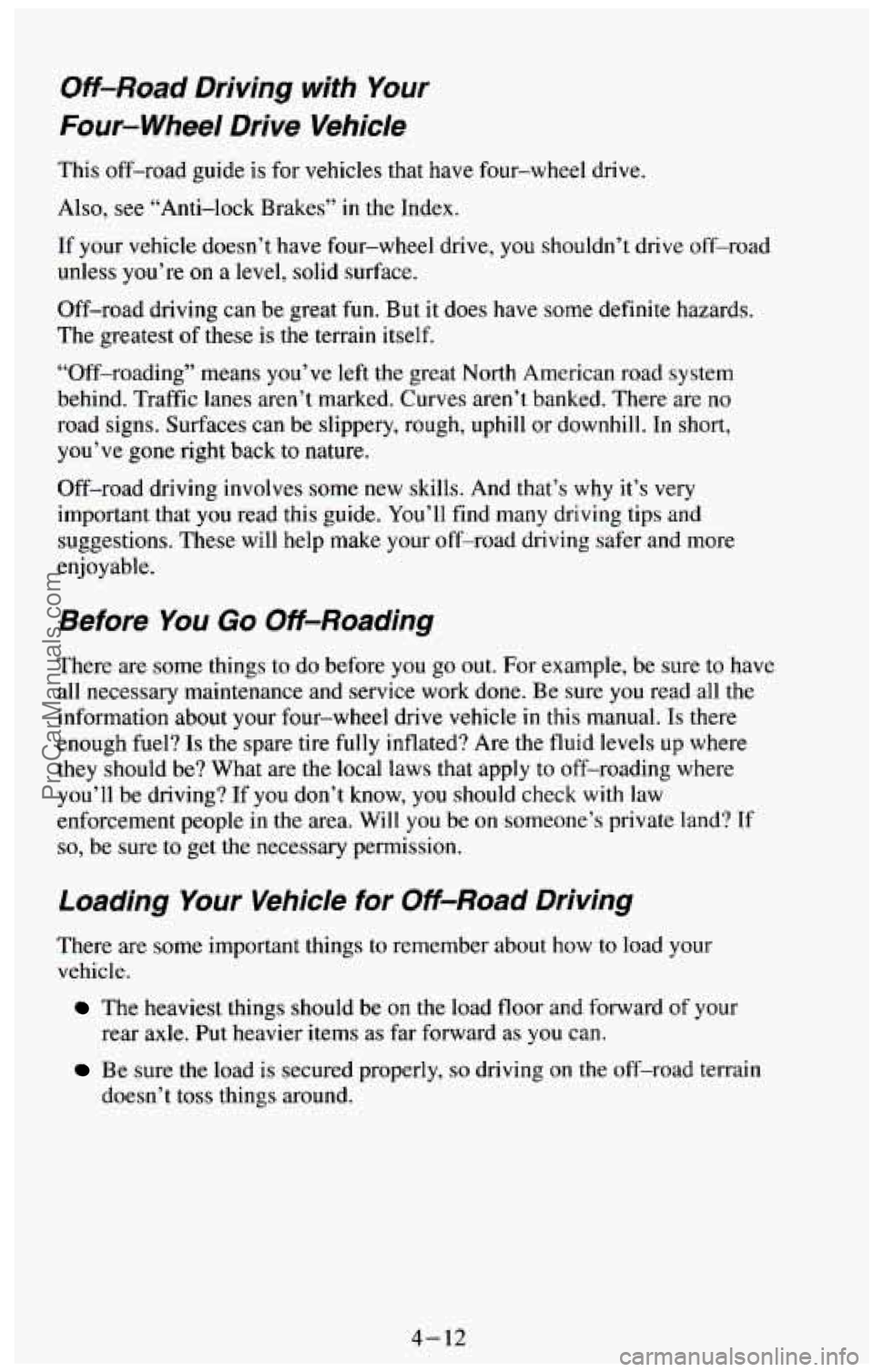
Off-Road Driving with Your
Four- Wheel Drive Vehicle
This off-road guide is for vehicles that have four-wheel drive.
Also, see “Anti-lock Brakes”
in the Index.
If your vehicle doesn’t have four-wheel drive, you shouldn’t drive off-road
unless you’re
on a level, solid surface.
Off-road driving
can be great fun. But it does have some definite hazards.
The greatest of these is the terrain itself.
“Off-roading” means you’ve left the great North American road system
behind. Traffic lanes aren’t marked. Curves aren’t banked. There are no
road signs. Surfaces can be slippery, rough, uphill or downhill. In short,
you’ve gone right back
to nature.
Off-road driving involves some new skills. And that’s
why it’s very
important that you read this guide. You’ll find many driving tips and
suggestions. These will help make your off-road driving safer and more
enjoyable.
Before You Go Off-Roading
There are some things to do before you go out. For example, be sure to have
all necessary maintenance and service work done. Be sure you read
all the
information about your four-wheel drive vehicle
in this manual. Is there
enough fuel?
Is the spare tire fully inflated? Are the fluid levels up where
they should be? What are the local laws that apply to off-roading where
you’ll be driving? If you don’t know, you should check
with law
enforcement people in the area. Will you be on someone’s private land? If
so, be sure to get the necessary permission.
Loading Your Vehicle for Off-Road Driving
There are some important things to remember about how to load your
vehicle.
The heaviest things should be on the load floor and forward of your
Be sure the load is secured properly, so driving on the off-road terrain
rear axle.
Put heavier items as far forward as you can.
doesn’t toss things around.
4-12
ProCarManuals.com
Page 228 of 385
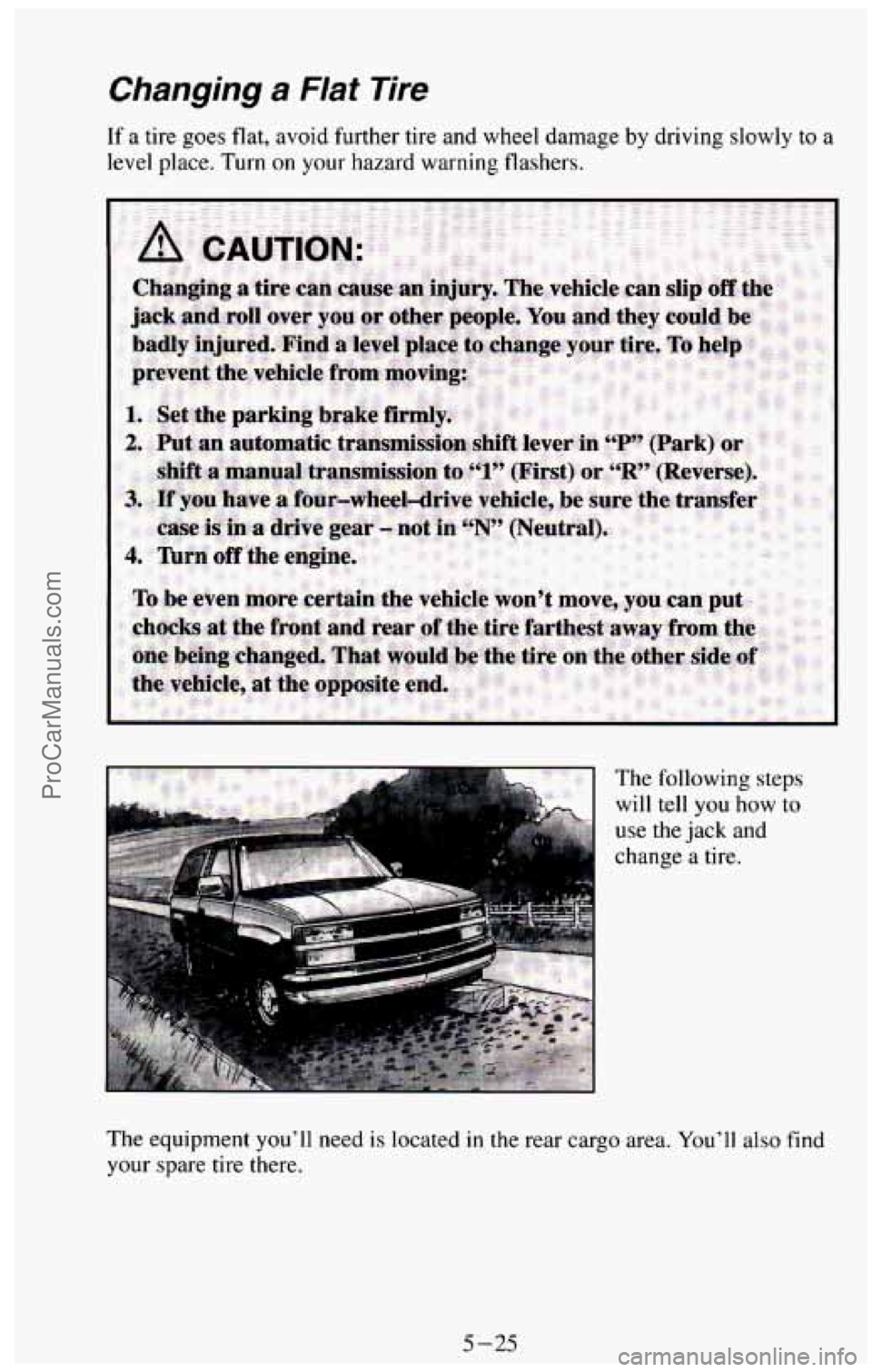
Changing a Flat Tire
If a tire goes flat, avoid further tire and wheel damage by driving slowly to a
level place. Turn on your hazard warning flashers.
The following
steps
will tell you how to
use the jack and
change
a tire.
The equipment you’ll need is located
in the rear cargo area. You’ll also find
your spare tire there.
5-25
ProCarManuals.com
Page 234 of 385
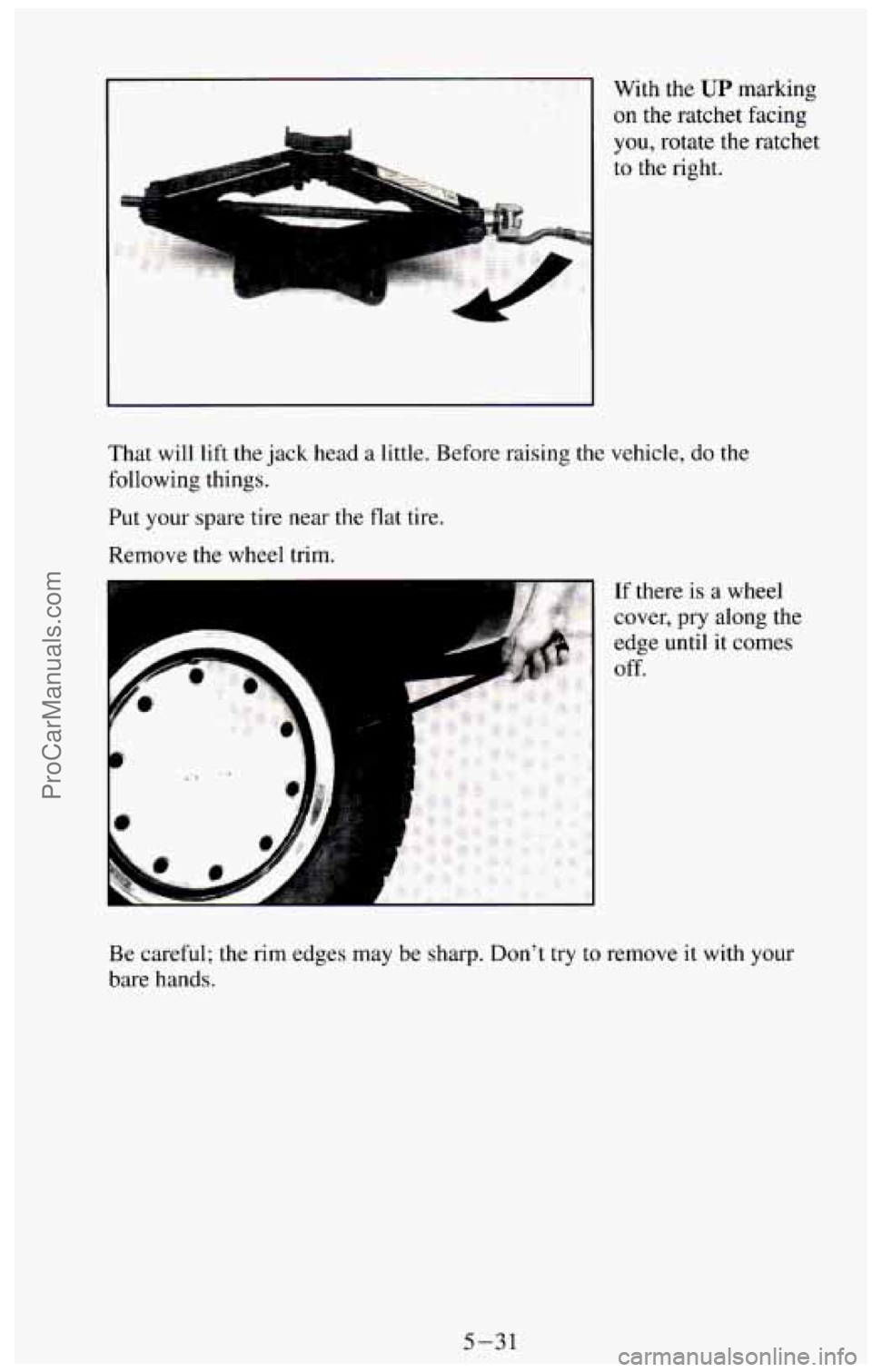
With the UP marking
on the ratchet facing
you, rotate the ratchet
to the right.
That will
lift the jack head a little. Before raising the vehicle, do the
following things.
Put your spare tire near the flat tire.
Remove the wheel trim.
i
2’
If there is a wheel
cover, pry along the
edge until it comes
off.
Be careful; the rim
edges may be sharp. Don’t try to remove it with your
bare hands.
5-31
ProCarManuals.com
Page 237 of 385
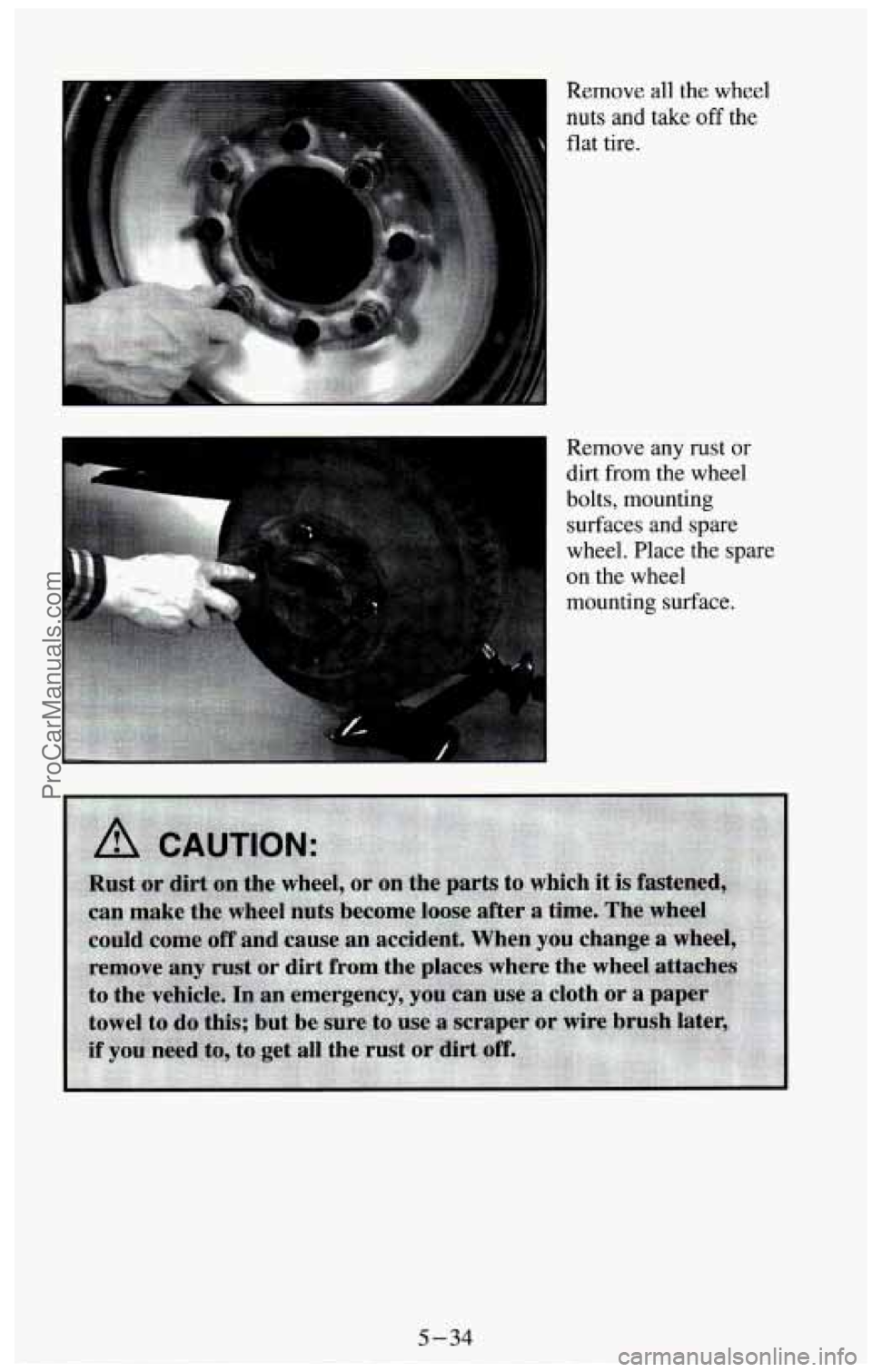
Remove all the wheel
nuts and take
off the
flat tire.
Remove any rust
or
dirt from the wheel
bolts, mounting surfaces and
spare
wheel. Place the spare
on the wheel
mounting surface.
ProCarManuals.com
Page 242 of 385
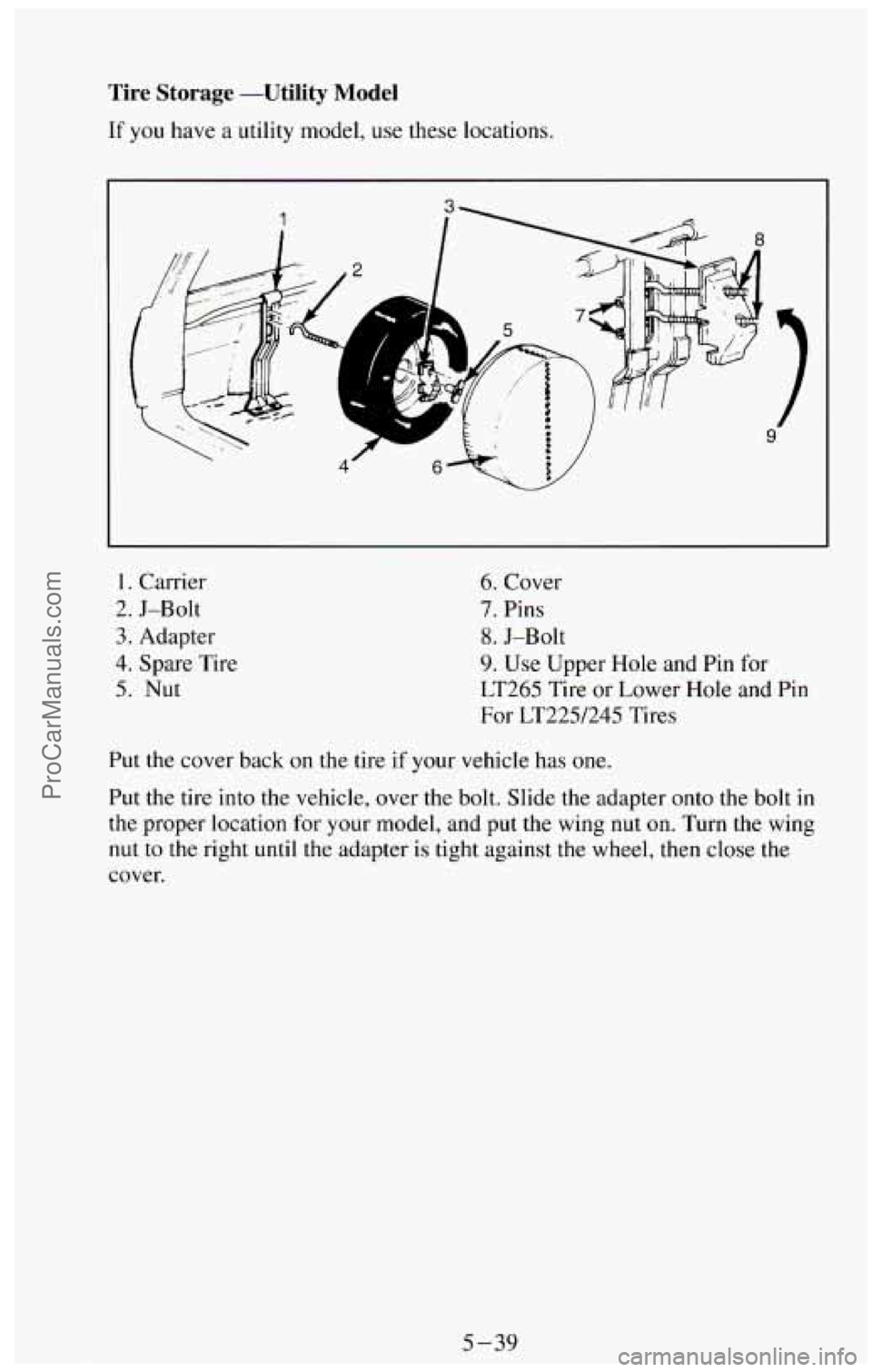
Tire Storage -Utility Model
If you have a utility model, use these locations.
1. Carrier
3. Adapter
4. Spare Tire
5. Nut
2. J-Bolt
6. Cover
7. Pins
9. Use Upper
Hole and Pin for
LT265 Tire or Lower Hole and Pin
For LT225/245 Tires
8. J-Bolt
Put the cover back on the tire if your vehicle has one.
Put the tire into the vehicle, over the bolt. Slide the adapter onto the bolt in
the proper location for your model, and put the wing
nut on. Turn the wing
nut to the right until the adapter is tight against the wheel, then close the
cover.
5-39
ProCarManuals.com
Page 357 of 385
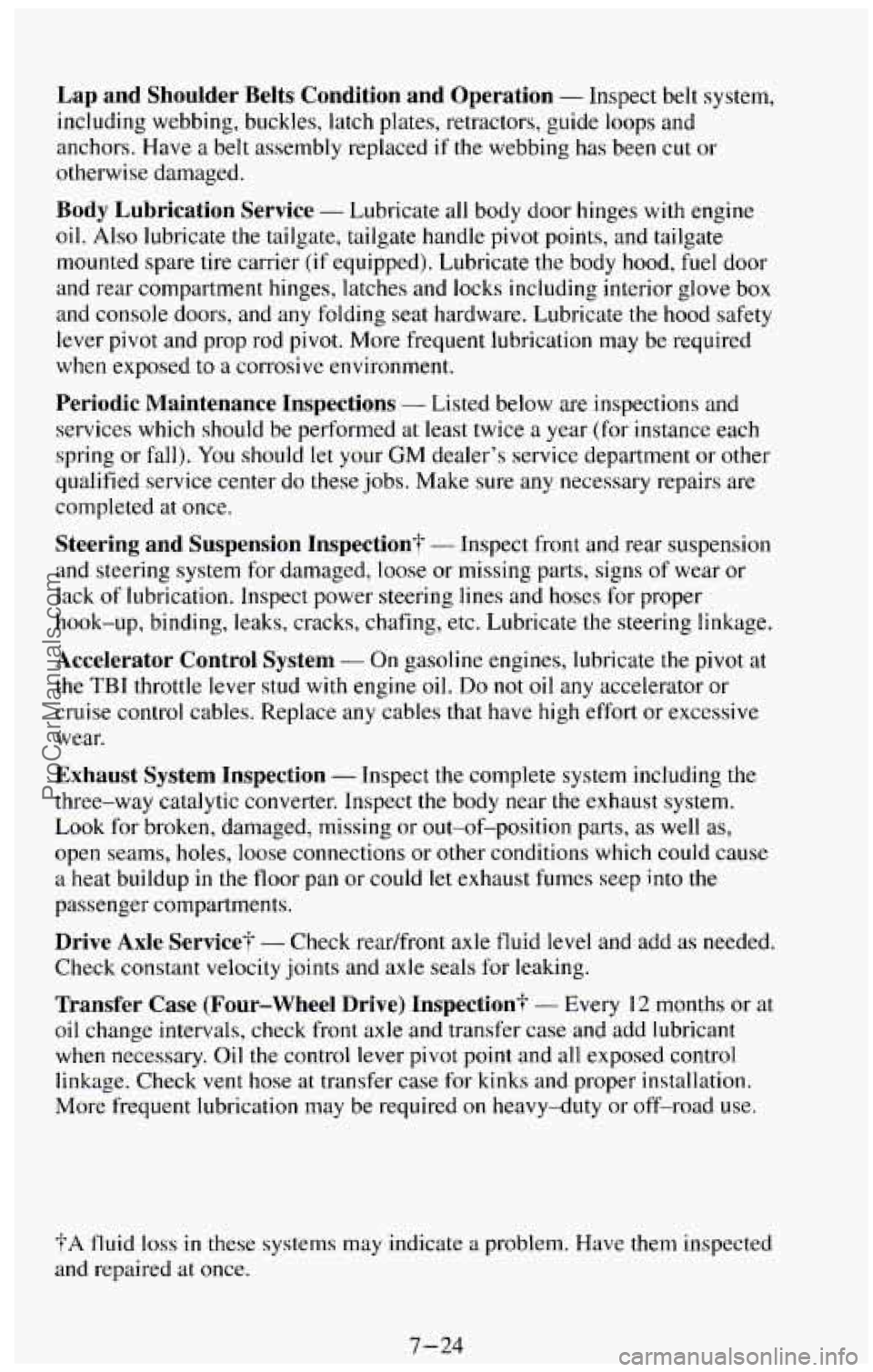
Lap and Shoulder Belts Condition and Operation - Inspect belt system,
including webbing, buckles, latch plates, retractors, guide loops\
and
anchors. Have
a belt assembly replaced if the webbing has been cut or
otherwise damaged.
Body Lubrication Service - Lubricate all body door hinges with engine
oil.
Also lubricate the tailgate, tailgate handle pivot points, and tailgate
mounted spare tire carrier (if equipped). Lubricate the body hood,
fuel door
and rear compartment hinges, latches and locks including interior glove box
and console doors, and any folding seat hardware. Lubricate the hood safety
lever pivot and prop rod pivot. More frequent lubrication may be required
when exposed to
a corrosive environment.
Periodic Maintenance Inspections - Listed below are inspections and
services which should be performed at least twice
a year (for instance each
spring or fall). You should let your
GM dealer’s service department or other
qualified service center do
these jobs. Make sure any necessary repairs are
completed at once.
Steering and Suspension Inspection? - Inspect front and rear suspension
and steering system for damaged, loose or missing parts, signs
of wear or
lack of lubrication. Inspect power steering lines and hoses for proper
hook-up, binding, leaks, cracks, chafing, etc. Lubricate the steering linkage.
Accelerator Control System - On gasoline engines, lubricate the pivot at
the
TBI throttle lever stud with engine oil. Do not oil any accelerator or
cruise control cables. Replace any cables that have high effort or excessive
wear.
Exhaust System Inspection - Inspect the complete system including the
three-way catalytic converter. Inspect the body near
the exhaust system.
Look for broken, damaged, missing or out-of-position parts,
as well as,
open seams, holes, loose connections or other conditions which could cause
a heat buildup
in the floor pan or could let exhaust fumes seep into the
passenger compartments.
Drive Axle Service? - Check readfront axle tluid level and add as needed,
Check constant velocity joints and axle seals for leaking.
Transfer Case (Four-wheel Drive) Inspection+ - Every 12 months or at
oil change intervals, check front axle and transfer case and add lubricant
when necessary. Oil the control lever pivot point and all exposed control
linkage. Check
vent hose at transfer case for kinks and proper installation.
More frequent lubrication may be required on heavy-duty or off-road use.
?A fluid loss in these systems may indicate a problem. Have them inspected
and repaired at once.
7-24
ProCarManuals.com
Page 383 of 385
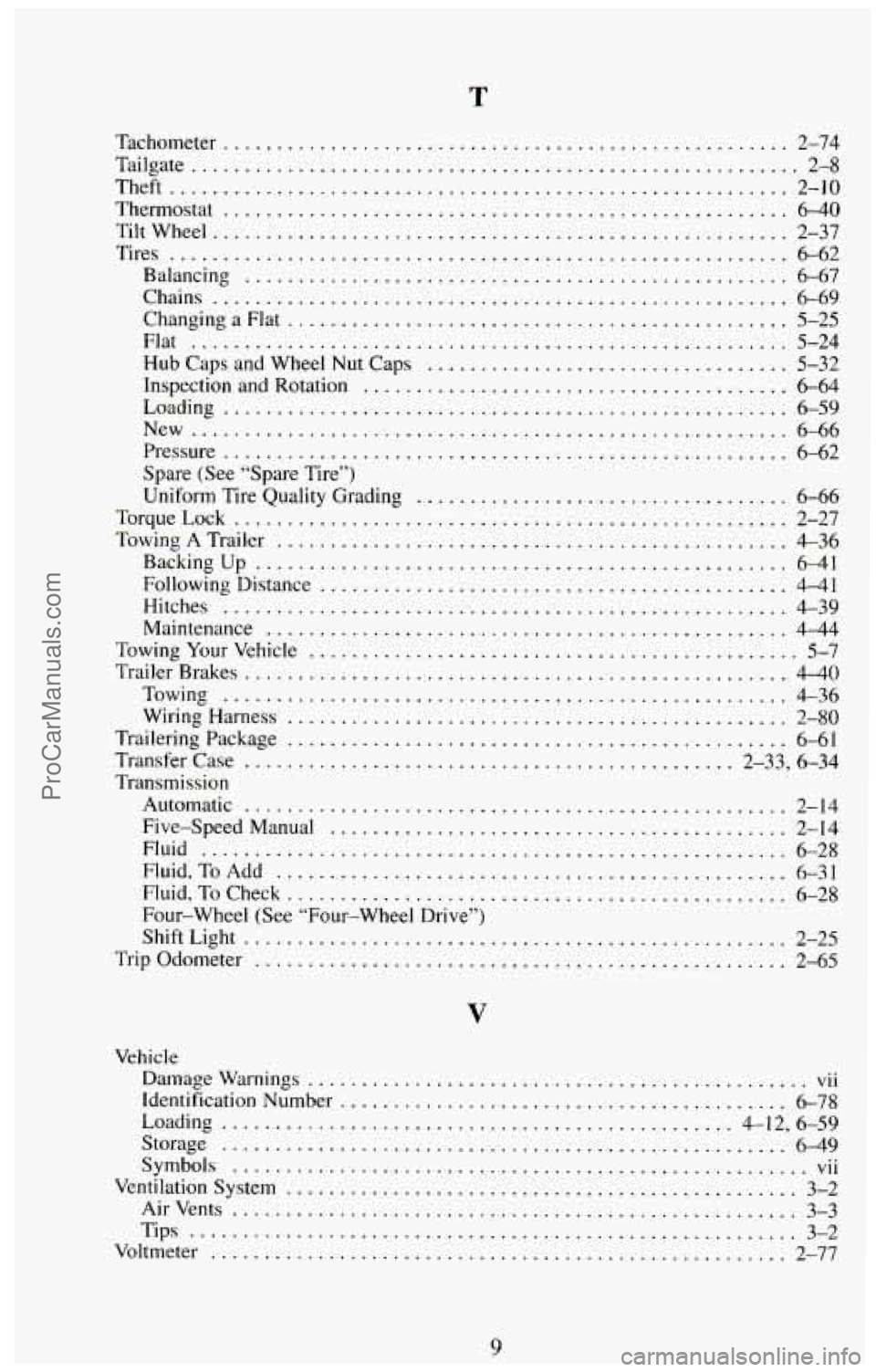
T
Tachometer ..................................................... 2-74
Tailgate
......................................................... 2-8
Theft
.......................................................... 2-10
Thermostat
..................................................... 6-40
Tiltwheel ...................................................... 2-37
Tires
.......................................................... 6-62
Balancing
................................................... 6-67
Chains ...................................................... 6-69
Flat
........................................................ 5-24
HubCapsandWheelNutCaps
.................................. 5-32
Loading
..................................................... 6-59
New ........................................................ 6-66
Pressure
..................................................... 6-62
Spare (See “Spare Tire”)
Uniform Tire Quality Grading
................................... 6-66
Towing
A Trailer ................................................ 4-36
Following Distance
............................................ 441
ChangingaFlat ............................................... 5-25
Inspection and Rotation ........................................ 6-64
TorqueLock
.................................................... 2-27
Backingup
.................................................. 6-41
Hitches
..................................................... 4-39
Maintenance
................................................. 4-44
TowingYourVehicle
.............................................. 5-7
TrailerBrakes
................................................... 4-40
Towing
..................................................... 4-36
Wiring Harness
............................................... 2-80
Trailering Package ............................................... 6-61
Transfer Case
.............................................. 2-33, 6-34
Transmission Automatic
................................................... 2-14
Five-SpeedManual
........................................... 2-14
Fluid
....................................................... 6-28
Fluid, ToAdd
................................................ 6-31
Four-wheel (See “Four-wheel Drive”)
Fluid,
To Check
............................................... 6-28
ShiftLight
................................................... 2-25
Tripodometer
.................................................. 2-65
Vehicle
Damage Warnings ............................................... vii
Identification Number .......................................... 6-78
Loading
................................................ 4-12. 6-59
Storage
..................................................... 649
Symbols ...................................................... vii
AirVents ..................................................... 3-3
Tips
......................................................... 3-2
Voltmeter
...................................................... 2-77
Ventilation System
................................................ 3-2
9 ProCarManuals.com